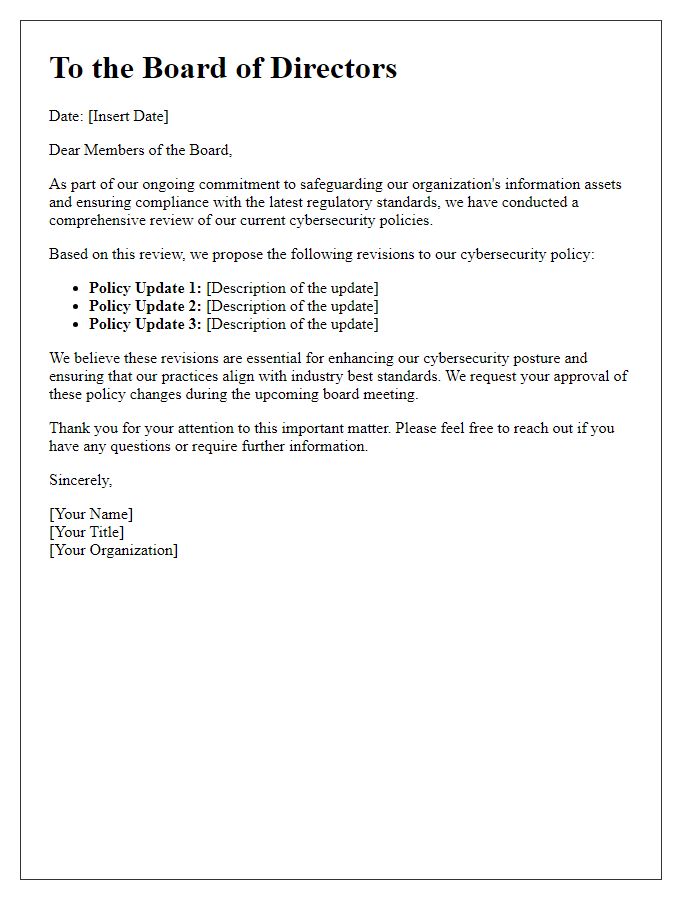In today's fast-paced digital landscape, the need for robust cybersecurity measures has never been more critical for organizations. As a board director, staying updated on our cybersecurity policies is essential for safeguarding our assets and ensuring compliance with industry standards. This letter serves as a pivotal reminder of our commitment to maintaining a secure environment for both our employees and clients. So, let's delve into the latest updates and initiatives that we have implemented in our cybersecurity strategyâread on to discover how we can collectively strengthen our defenses!

Identification of emerging threats and vulnerabilities.
Emerging threats and vulnerabilities in the cybersecurity landscape require timely identification and assessment to protect organizational integrity. Recent data breaches, affecting over 100 million records globally, illustrate the growing sophistication of cybercriminals utilizing advanced techniques such as ransomware and phishing attacks. Technologies like Artificial Intelligence (AI) and Machine Learning (ML) are increasingly exploited by attackers to enhance their capabilities, creating challenges for traditional defense mechanisms. Critical infrastructure, including healthcare systems and financial institutions, has witnessed a surge in targeted attacks, with incidents doubling in the last year alone. Additionally, the rise of the Internet of Things (IoT) devices, numbering over 30 billion by 2023, presents new vulnerabilities due to inadequate security measures. Continuous monitoring, employee training, and robust policy updates are essential strategies to mitigate these evolving risks effectively.
Compliance with regulatory requirements and standards.
The cybersecurity policy update emphasizes the necessity for compliance with regulatory requirements and industry standards such as the General Data Protection Regulation (GDPR) and the Cybersecurity Framework established by the National Institute of Standards and Technology (NIST). Adhering to these guidelines ensures the safeguarding of sensitive data and minimizes potential risks of data breaches, which can lead to significant financial repercussions and loss of consumer trust. Regular assessments and audits will be conducted to measure adherence to these policies as part of a proactive risk management strategy. Training programs will be implemented to equip employees with knowledge about current threats and compliance obligations, thereby fostering a culture of security awareness across the organization.
Integration of advanced security technologies.
The integration of advanced security technologies is crucial for enhancing the cybersecurity strategy of organizations, especially in light of recent data breaches impacting large corporations such as SolarWinds in 2020 and Colonial Pipeline in 2021. Implementing artificial intelligence (AI) and machine learning (ML) solutions enables proactive threat detection, automating the identification of anomalies within network traffic. Utilizing advanced encryption protocols, like AES-256, fortifies data integrity, shielding sensitive information from potential ransomware attacks that have risen by 300% in recent years. Additionally, multi-factor authentication (MFA) adoption across platforms adds an essential layer of protection, reducing the risk of unauthorized access by over 90%. Regular updates and training sessions on these technologies for all employees ensure a robust defense against evolving cyber threats. Comprehensive risk assessments utilizing frameworks such as NIST Cybersecurity Framework will help identify vulnerabilities and implement tailored strategies that align with organizational goals and industry standards.
Alignment with organizational goals and risk management.
The cybersecurity policy update is essential for maintaining the integrity of digital assets within organizations. This update will align with organizational goals, such as safeguarding sensitive data, enhancing customer trust, and ensuring compliance with relevant regulations like the General Data Protection Regulation (GDPR). Key risk management strategies will be outlined, focusing on threat detection, incident response, and employee training to mitigate vulnerabilities. Regular assessments will be implemented to evaluate the effectiveness of the cybersecurity measures, ensuring they adapt to evolving threats and support business objectives. Stakeholders, including IT specialists and executive management, will collaborate to foster a culture of security awareness across the organization, further integrating cybersecurity into daily operations.
Governance and accountability structures.
The recent cybersecurity policy update emphasizes crucial governance and accountability structures essential for safeguarding sensitive data across all operational levels. The Board of Directors (comprising 12 members) must ensure compliance with industry standards (ISO/IEC 27001) while fostering a culture of security awareness among employees (over 1,500 personnel). Key elements include the establishment of a Cybersecurity Committee responsible for overseeing risk assessments and incident response strategies (including a timeline for annual reviews). Clear lines of reporting must be articulated, linking department heads (such as IT, HR) to the Chief Information Security Officer (CISO) for immediate escalation of security incidents. Regular training sessions are mandated to enhance personnel competency regarding phishing threats and data protection best practices. These structures are integral to maintaining the organization's cybersecurity resilience and overall organizational integrity.
Letter Template For Board Director Cybersecurity Policy Update Samples
Letter template of cybersecurity policy revisions for the board of directors.

Letter template of cybersecurity strategy adjustments for board approval.

Letter template of cybersecurity governance update for executive directors.

Letter template of board communication on cybersecurity compliance updates.

Letter template of cybersecurity framework update for board consideration.









Comments